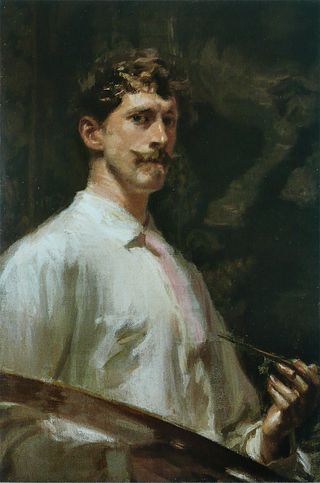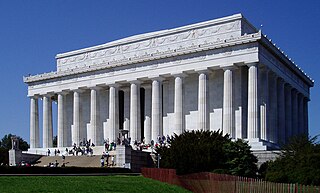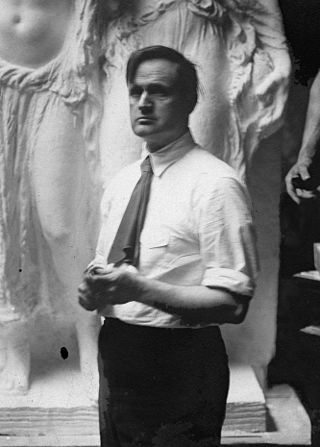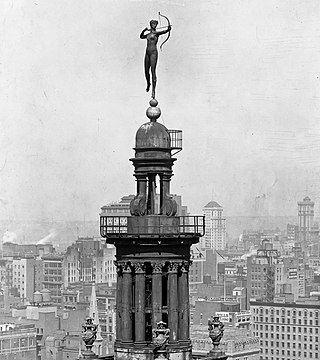Albert Jaegers | |
|---|---|
 Albert Jaegers | |
| Born | March 28, 1868 |
| Died | July 22, 1925 (aged 57) |
| Known for | sculpture |
Albert Jaegers (March 28, 1868 – July 22, 1925) was an American sculptor.
Albert Jaegers | |
|---|---|
 Albert Jaegers | |
| Born | March 28, 1868 |
| Died | July 22, 1925 (aged 57) |
| Known for | sculpture |
Albert Jaegers (March 28, 1868 – July 22, 1925) was an American sculptor.
Jaegers was born on March 28, 1868, in Elberfeld, Germany. He moved with his family to Cincinnati, Ohio, as a boy. He apprenticed to his father as a wood carver, then studied at the Cincinnati Art Academy, and later in London, Paris, and Rome. [1]
In 1890, he married Matilda Holdt and launched his career as a sculptor. [1] He won competitions sponsored by the National Sculpture Society. [1]
He exhibited at the Pan-American Exposition (1901) and Louisiana Purchase Exposition (1904). [1] For the latter he was commissioned to create the statue representing Arkansas. [2]

In 1906 he won the commission for the Steuben Monument in Washington, D.C., on the basis of the endorsement of his work at an early stage of the competition by Augustus Saint-Gaudens. His bronze sculptures included an eleven-foot-high figure of the military leader set atop a granite pedestal almost 20 feet high. Alongside the pedestal are two groups. In the one called "Commemoration," a seated female figure, unclothed above the waist, represents America instructing a small child from a scroll he holds up to her as he kneels at her feet. In the other, "Military Instruction," a seated adult soldier, naked but for an elaborate helmet, "in the prime of life," holds an empty scabbard in one hand. With his other hand, as if providing instruction, he points to his unsheathed sword, held by the naked young man at his side. [3]
When the U.S. government selected sculptors to create figures for the U.S. Custom House in New York City, each of which was to represent an historic seafaring power, Jaegers won the commission to create the one for Germany, which he planned as "an armed female figure, leaning on an antique shield, inscribed 'Kiel.'" [4] Following the U.S. declaration of war on Germany in 1917, Secretary of the Treasury McAdoo asked him to modify it to represent Belgium, a U.S. ally in World War I. Jaegers refused to alter it, but the sculpture was modified over his objections. [5] [6] He said his work could not be seriously modified with "a little camouflage with a relabel" and called the change of name "a somewhat dubious honor for plucky little Belgium." [1]
His sculptures of German-American historical figures were sometimes targeted when the U.S. and Germany were at war. The dedication of his figure of Monsignor Anthony Stein met with protest and threats of violence. [7] The dedication of his statue of Francis Daniel Pastorius, the founder of Germantown, Pennsylvania, was delayed until after the end of World War I, and it was later removed from view during World War II. [8]
In 1918 he contributed a small sculpture called "The Grenade Thrower" to a show of patriotic and war-related pieces. [9]
Jaegers was a member of the National Sculpture Society and the National Institute of Arts and Letters. [1] He was the brother of sculptor Augustine Jaegers (1878 – 1952), whose career paralleled his. [10]
He lived on Washington Square Park in New York City. [11]
He died from heart disease on July 22, 1925, in Suffern, New York, and was buried at Airmont Cemetery, there. [12]

Frederick William MacMonnies was the best known expatriate American sculptor of the Beaux-Arts school, as successful and lauded in France as he was in the United States. He was also a highly accomplished painter and portraitist. He was born in Brooklyn Heights, Brooklyn, New York and died in New York City.

Henry Bacon was an American Beaux-Arts architect who oversaw the engineering and design of the Lincoln Memorial in Washington, D.C., built between 1915 and 1922, which was his final project before his 1924 death.

Augustus Saint-Gaudens was an American sculptor of the Beaux-Arts generation who embodied the ideals of the American Renaissance. From an Irish-French family, Saint-Gaudens was raised in New York City. He traveled to Europe for further training and artistic study. After he returned to New York, he achieved major critical success for his monuments commemorating heroes of the American Civil War, many of which still stand. Saint-Gaudens created works such as the Robert Gould Shaw Memorial on Boston Common, Abraham Lincoln: The Man, and grand equestrian monuments to Civil War generals: General John Logan Memorial in Chicago's Grant Park and William Tecumseh Sherman at the corner of New York's Central Park. In addition, he created the popular historicist representation of The Puritan.

James Earle Fraser was an American sculptor during the first half of the 20th century. His work is integral to many of Washington, D.C.'s most iconic structures.

Alexander Phimister Proctor was an American sculptor with the contemporary reputation as one of the nation's foremost animaliers.

Frederick George Richard Roth often referred to as F.G.R. Roth, was an American sculptor and animalier, well known for portraying living animals. The statue of the sled dog Balto in New York City's Central Park is perhaps his most famous piece.

The history of sculpture in the United States begins in the 1600s "with the modest efforts of craftsmen who adorned gravestones, Bible boxes, and various utilitarian objects with simple low-relief decorations." American sculpture in its many forms, genres and guises has continuously contributed to the cultural landscape of world art into the 21st century.

Bela Lyon Pratt was an American sculptor from Connecticut.

Mary Lawrence (Tonetti) (1868–1945) was an American sculptor. She designed the Christopher Columbus sculpture at the World's Columbian Exposition.

The Adams Memorial is a grave marker for Marian Hooper Adams and Henry Adams located in Section E of Rock Creek Cemetery, Washington, D.C. The memorial features a cast bronze allegorical sculpture by Augustus Saint-Gaudens. Saint-Gaudens' shrouded-figure statue is seated against a granite block which takes up one side of a hexagonal plaza, designed by architect Stanford White. Across from the statue is a stone bench for visitors. The whole is sheltered by a close screen of dense conifers.

Philip H. Martiny was a French-American sculptor who worked in the Paris atelier of Eugene Dock, where he became foreman before emigrating to New York in 1878—to avoid conscription in the French army, he later claimed. In the United States he found work with Augustus Saint-Gaudens, with whom he remained five years; a fellow worker in Saint-Gaudens' shop was Frederick MacMonnies. A group photograph taken in Saint-Gaudens's studio about 1883, conserved in the Archives of American Art, shows Kenyon Cox, Richard Watson Gilder, Martiny, Francis Davis Millet, Saint-Gaudens, Julian Alden Weir and Stanford White.

Jakob Otto Schweizer was a Swiss-American sculptor noted for his work on war memorials.

Major General Friedrich Wilhelm von Steuben is a bronze statue of Friedrich Wilhelm von Steuben, executed by sculptor Albert Jaegers. It is erected in Lafayette Park in Washington, D.C.
Louis Saint-Gaudens was a significant American sculptor of the Beaux-Arts generation. He was the brother of renowned sculptor Augustus Saint-Gaudens; Louis later changed the spelling of his name to St. Gaudens to differentiate himself from his well-known brother.

Carl Wilhelm Daniel Rohl-Smith was a Danish American sculptor who was active in Europe and the United States from 1870 to 1900. He sculpted a number of life-size and small bronzes based on Greco-Roman mythological themes in Europe as well as a wide number of bas-reliefs, busts, funerary monuments, and statues throughout Denmark, the German Confederation, and Italy. Emigrating to the United States in 1886, he once more produced a number of sculptures for private citizens. His most noted American works were a statue of a soldier for a Battle of the Alamo memorial in Texas, a statue of Benjamin Franklin for the World's Columbian Exposition in 1893, a statue group in Chicago commemorating the Fort Dearborn Massacre, and the General William Tecumseh Sherman Monument in Washington, D.C.

Diana – also known as Diana of the Tower – is an iconic statue by sculptor Augustus Saint-Gaudens, representing the goddess Diana. Once a major artistic feature of New York City, the second version stood atop the tower of Madison Square Garden from 1893 to 1925. Since 1932, it has been in the collection of the Philadelphia Museum of Art.

William Clark Noble was an American sculptor best known for his monuments.
Lawrence Joseph Nowlan Jr. was an American sculptor and figurative artist known for his statues of notable individuals, including Harry Kalas and Jackie Gleason. Nowlan also designed memorials, including the firefighter sculptures at the Wildland Firefighters National Monument in Boise, Idaho, which was his first commission as a sculptor, and the war memorial in Windsor, Vermont. Additionally, Nowlan created the statuette awarded by several major ceremonies, including the ESPN ESPY Award and the My VH1 Music Awards. He was working on an 8-foot, 800 pound statue of Philadelphia boxer, Joe Frazier, at the time of his death in 2013.

William Tecumseh Sherman, also known as the Sherman Memorial or Sherman Monument, is a sculpture group honoring William Tecumseh Sherman, created by Augustus Saint-Gaudens and located at Grand Army Plaza in Manhattan, New York. Cast in 1902 and dedicated on May 30, 1903, the gilded-bronze monument consists of an equestrian statue of Sherman and an accompanying statue, Victory, an allegorical female figure of the Greek goddess Nike. The statues are set on a Stony Creek granite pedestal designed by the architect Charles Follen McKim.

Bruno Louis Zimm was an American sculptor. He created a variety of works: fountains, memorials, freestanding sculptures, and architectural sculptures.